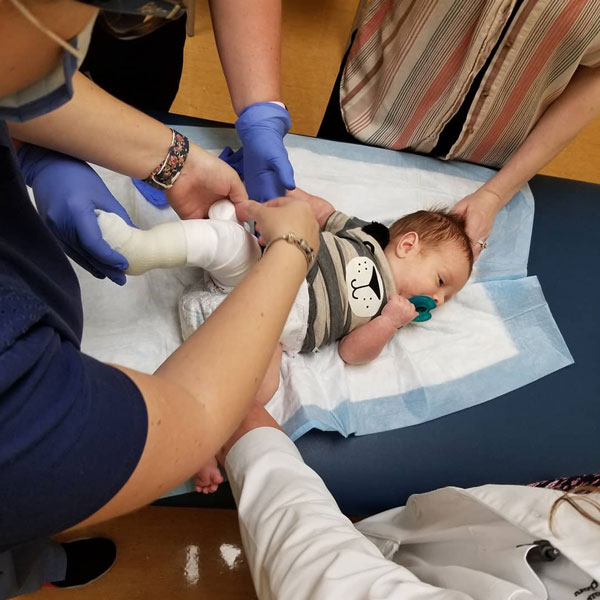Bowlegs & Knock-Knees
Bowlegs (Genu Varus)
“Why does my child walk like a little cowboy?” Bow-legged, or genu varus, is the most common reason children under 2 years of age see an orthopedist. It is actually more common in this age group to have mild bow-legs than to not!
If we examine the natural progression of lower limb alignment in a growing child, we can appreciate the typical changes over time and the wide range of what can be considered normal.

Determining if Treatment is Needed
After age two, genu varum may persist without an underlying pathologic cause. It is simply termed physiologic leg bowing. Bowlegged children often have internal tibial torsion or inward twisting of the shinbones. Torsion is also a normal physiologic finding, but it can accentuate the bowing appearance and make the condition look more severe than it actually is. Physiologic bowing will resolve on its own over time. Your doctor will examine your child to differentiate normal bowing versus abnormal bowlegs.

Blounts Disorder
Infantile Blounts, or pathologic tibia vara, occurs when an abnormal growth plate causes a progressive bowing deformity. X-rays can help differentiate the diagnosis but are not always conclusive in the early stages of Blounts. Sometimes repeat X-rays are taken every 4-6 months to monitor your child’s alignment. You can also take standing photos every few months which can be almost as useful as X-rays (and less radiation!)
Unlike physiologic bowing, Blounts will worsen with time. The long-term consequence of varus alignment is the risk of knee pain and degenerative arthritis. Blount’s may also occur during adolescence, usually associated with obesity. Other pathologic causes of leg-bowing include growth arrest (e.g. fractures of the growth plate) and metabolic bone disease (e.g. Rickets).
Treatment for Bowlegs
Watchful waiting is the only treatment needed for physiologic bowing, as it will improve gradually with time. However, Blounts requires treatment and in the early stages is potentially reversible to normal. Leg braces, called KAFOs (knee-ankle-foot-orthosis) are the treatment of choice for children under 3 years old. Unfortunately, braces are not always effective in treating Blounts. Due to the abnormal growth plate, there is a risk of recurrence throughout childhood.
Surgery may be required for Blounts. Your physician will discuss treatment options which may include a minor surgery called “guided growth” (hemi-epiphysiodesis) or bone realignment surgery, termed an osteotomy.
Knock-Knees (Genu Valgus)
Genu valgus is common in growing children, especially after age 3. If knock-knees are present equally in both legs and is not causing symptoms, physiologic valgus is the most likely diagnosis. Although physiologic valgus is considered normal, it may be a cosmetic concern for kids and parents. Your doctor may order standing X-rays every 6 months to ensure alignment is improving. If leg alignment is not worsening, most doctors prefer observing until 8 years of age, as the majority of children with knock-knees will improve with time and not need treatment. Other causes of knock-knees that more frequently require surgery are growth plate injuries and metabolic disease (e.g. Rickets).
Leg braces have not been shown to be effective in treating knock-knees. In cases of persistent genu valgus, the preferred surgical method is “guided growth” (hemi-epiphysiodesis). It is a relatively safe and simple procedure that will straighten your child’s legs as they grow. Osteotomies, or cutting and realigning bones, are done for severe cases of genu valgum and in skeletally mature adolescents and adults.
See the page dedicated to our Limb Restoration Program for further detail on the treatment of pediatric limb deformities such as bowlegs & knock-knees.
